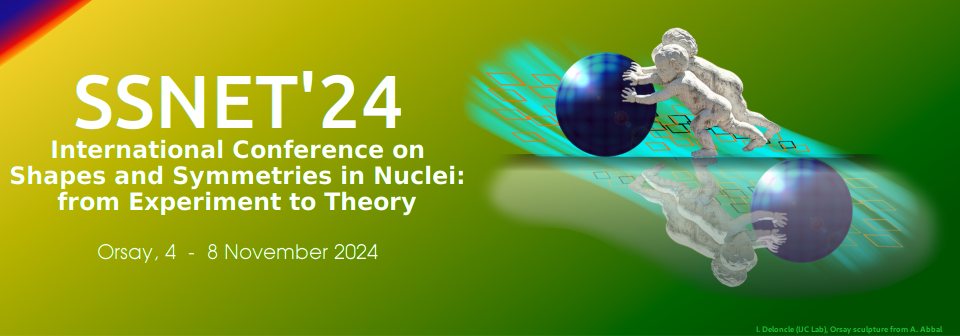Orateur
Description
Tellurium isotopes in the A $\approx$ 125 mass region are good candidates to study shape changes owing to their transitional nature. The h$_{11/2}$ intruder orbitals in this region drives the nuclear shape. The protons occupying the low-$\Omega$ h$_{11/2}$ orbitals drive the nucleus to a prolate shape while the neutrons in the mid to high $\Omega$ orbitals result in an oblate shape. Furthermore, the neighboring even-even nuclei -$^{124,126}$Te are said to possess E(5) critical point symmetry, corresponding a shape-phase transition between a spherical vibrator and a $\gamma$ unstable one[1]. As the $^{125}$Te nucleus can be considered a neutron hole coupled to the even-even core $^{126}$Te, we can also expect to observe various shape-change phenomena in this nucleus.
The excited nuclear states of $^{125}$Te were populated in the $\alpha$ induced reaction $^{124}$Sn($\alpha$, 3n)$^{125}$Te. The K-130 cyclotron at VECC, India, provided the $\alpha$ beam at an energy of 35 MeV. The de-exciting $\gamma$ rays were detected by the Indian National Gamma Array (INGA) spectrometer, comprising 7 Compton-suppressed HPGe detectors. The detectors were arranged as follows - 4 detectors at 90$^{\circ}$, 2 at 125$^{\circ}$ and one detector at 40$^{\circ}$. The digital data acquisition system was
based on PIXIE-16 (XIA LLC, USA) 12-bit 250 MHz digitizer modules[2]. Further analysis was performed using the RADWARE package[3].
In the present work, the previously obtained level scheme for $^{125}$Te[4,5] has been verified and expanded to about 39/2$\hbar$ by adding 83 new $\gamma$ transitions. In particular, the bands based on the 1/2$^{+}$ and 3/2$^{+}$ levels have been identified as signature partners. The signature splitting between the bands indicates triaxial deformation[6]. PES calculations show a change in $\gamma$ from -50.5$^{\circ}$ to 39.2$^{\circ}$. We interpret the results within the Particle Rotor model(PRM) framework. The calculations were performed with an even-even triaxial core of $^{126}$Te while considering a VMI (Variable Moment of Inertia) treatment for the core spectrum. We discuss probable configurations for the possible band structures obtained in the present work and the shape change effects observed.
References:
[1] S.F Hicks et al., Phys. Rev C 95:034322, (2017).
[2] S.Das et al., NIM A 893 138 (2018).
[3] D. Radford, NIM A 361 297 (1995).
[4] A.Kerek et al., Nucl. Phys.A, 194(1):64–80, (1972).
[5] A.Astier et al., Eur. Phys. J. A 50 (2013).
[6]L-C He et al., Chinese Phys. C 41(4):044003, (2017).

